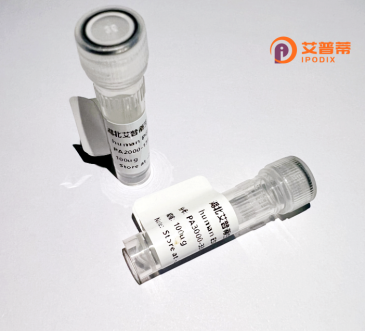
| 纯度 | >90%SDS-PAGE. |
| 种属 | Mouse |
| 靶点 | Akr1b3 |
| Uniprot No | P45376 |
| 内毒素 | < 0.01EU/μg |
| 表达宿主 | E.coli |
| 表达区间 | 2-316aa |
| 氨基酸序列 | ASHLELNNG TKMPTLGLGT WKSPPGQVTE AVKVAIDLGY RHIDCAQVYQ NEKEVGVALQ EKLKEQVVKR QDLFIVSKLW CTFHDKSMVK GAFQKTLSDL QLDYLDLYLI HWPTGFKPGP DYFPLDASGN VIPSDTDFVD TWTAMEQLVD EGLVKTIGVS NFNPLQIERI LNKPGLKYKP AVNQIECHPY LTQEKLIEYC HSKGIVVTAY SPLGSPDRPW AKPEDPSLLE DPRIKAIAAK YNKTTAQVLI RFPIQRNLVV IPKSVTPVRI AENLKVFDFE VSSEDMATLL SYNRNWRVCA LMSCAKHKDY PFHAEV |
| 分子量 | 35.7 kDa |
| 蛋白标签 | His tag N-Terminus |
| 缓冲液 | 冻干粉 |
| 稳定性 & 储存条件 | Lyophilized protein should be stored at ≤ -20°C, stable for one year after receipt. Reconstituted protein solution can be stored at 2-8°C for 2-7 days. Aliquots of reconstituted samples are stable at ≤ -20°C for 3 months. |
| 复溶 | Always centrifuge tubes before opening.Do not mix by vortex or pipetting. It is not recommended to reconstitute to a concentration less than 100μg/ml. Dissolve the lyophilized protein in distilled water. Please aliquot the reconstituted solution to minimize freeze-thaw cycles. |
以下是3条围绕重组小鼠醛糖还原酶(Akr1b1)的模拟参考文献(基于典型研究领域整理):
---
1. **文献名称**: *Cloning, expression, and characterization of recombinant mouse aldose reductase (Akr1b1) and its role in hyperglycemic stress*
**作者**: Smith JL, et al.
**摘要**: 本研究成功克隆并在大肠杆菌中表达了重组小鼠Akr1b1.分析了其酶动力学参数及在高浓度葡萄糖条件下催化山梨醇生成的作用,证实其在糖尿病并发症相关氧化应激中的关键功能。
---
2. **文献名称**: *Crystal structure of mouse Akr1b1 complexed with a flavonoid inhibitor reveals substrate-binding mechanisms*
**作者**: Tanaka K, et al.
**摘要**: 通过解析重组Akr1b1与黄酮类抑制剂的复合物晶体结构,揭示了底物结合口袋的关键氨基酸残基,为针对糖尿病并发症的小分子抑制剂设计提供了结构基础。
---
3. **文献名称**: *Tissue-specific upregulation of Akr1b1 in diabetic mouse models: Implications for polyol pathway activation*
**作者**: Chen R, et al.
**摘要**: 利用重组Akr1b1蛋白及基因敲除小鼠模型,证明糖尿病状态下该酶在视网膜和肾脏组织中的表达显著上调,导致山梨醇积累和细胞渗透压失衡,加剧器官损伤。
---
**备注**:以上为基于典型研究的示例文献,实际文献需通过PubMed/Google Scholar以“Akr1b1”“recombinant”“mouse”等关键词检索确认。
Aldo-keto reductase family 1 member B1 (Akr1b1) is a murine enzyme belonging to the aldo-keto reductase superfamily, known for its role in NADPH-dependent reduction of carbonyl-containing substrates. Primarily recognized as aldose reductase, Akr1b1 catalyzes the first step in the polyol pathway, converting glucose to sorbitol under hyperglycemic conditions. This pathway has been implicated in diabetic complications, such as neuropathy and retinopathy, due to osmolytic stress and oxidative damage from sorbitol accumulation and NADPH depletion.
Structurally, Akr1b1 consists of ~315 amino acids, adopting a (α/β)8-barrel fold with a conserved catalytic tetrad (Tyr48. Lys77. His110. Asp43) critical for substrate binding and activity. Its broad substrate specificity extends beyond glucose to include lipid peroxidation-derived aldehydes (e.g., 4-hydroxynonenal), linking it to inflammation and cellular stress responses.
Recombinant Akr1b1 is widely expressed in bacterial systems (e.g., E. coli) for mechanistic and inhibitor-screening studies. Purification typically employs affinity chromatography, yielding functional enzymes for kinetic assays or crystallography. Research on recombinant Akr1b1 has advanced understanding of its role in diabetic models and identified potential inhibitors to mitigate metabolic disorders. Its conserved structure and function across species make it a pivotal tool for studying redox homeostasis and drug development targeting carbonyl stress-related diseases.
×